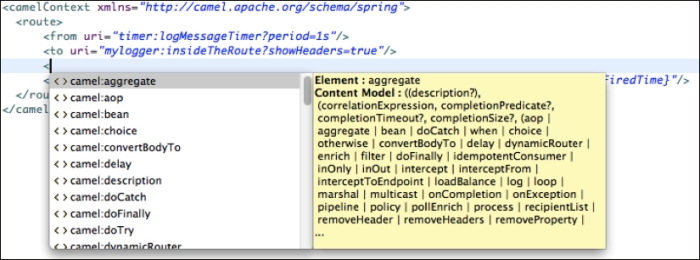This recipe will show you how to integrate Camel into a Spring application.
When using Camel within a Spring application, it is necessary to add the following dependencies to the minimal set defined in the Using Camel in a Java application recipe in this chapter:
<dependency>
<groupId>org.apache.camel</groupId>
<artifactId>camel-spring</artifactId>
<version>${camel-version}</version>
</dependency>
<dependency>
<groupId>org.apache.camel</groupId>
<artifactId>camel-test-spring</artifactId>
<version>${camel-version}</version>
<scope>test</scope>
</dependency>The ${camel-version} property is defined once in the Maven POM.
The Java code for this recipe is located in the org.camelcookbook.structuringroutes.simplespring package. The Spring XML files are located under src/main/resources/META-INF/spring and prefixed with simplespring.
In order to embed Camel into a Spring application, perform the following steps:
- In the XML namespace declaration, define the Camel schema alongside any Spring schemas in use:
<beans xmlns="http://www.springframework.org/schema/beans" xmlns:camel="http://camel.apache.org/schema/spring" xmlns:xsi="http://www.w3.org/2001/XMLSchema-instance" xsi:schemaLocation=" http://www.springframework.org/schema/beans http://www.springframework.org/schema/beans/spring-beans.xsd http://camel.apache.org/schema/spring http://camel.apache.org/schema/spring/camel-spring.xsd">
- The
camelContextelement should be defined once within the Spring configuration, and it should use the Camel Spring namespace. This signifies that everything within it will be considered Camel configuration as opposed to Spring.<camelContext xmlns="http://camel.apache.org/schema/spring"> <!-- routing logic goes here --> </camelContext> - Routes can then be defined within the
camelContextelement using the XML DSL:<route> <from uri="timer:logMessageTimer?period=1s"/> <to uri="mylogger:insideTheRoute?showHeaders=true"/> <log message="Event triggered by ${property.CamelTimerName} at ${header.CamelTimerFiredTime}"/> </route>
Camel was designed to be closely integrated with Spring from its inception. The camelContext element results in a SpringCamelContext object being created, initialized with any routes defined within it, and started when the Spring context starts up. The camelContext element is itself a Spring managed object that can optionally be given an ID and treated like any other bean.
The preceding example shows Camel's XML DSL being used. One of the nice things about the DSL is that an XML schema is used to define it. This means that it is possible for your IDE to provide you with code completion.

It is not mandatory to use the XML DSL with Spring. It is possible to use the Java DSL instead, or alongside routes defined through the XML DSL.
To plug in the route defined in the LogMessageOnTimerEventRouteBuilder class that we used in the previous recipe, we first instantiate it as a bean:
<!-- package name has been abbreviated -->
<bean id="logMessageOnTimerEvent"
class="org.camelcookbook.structuringroutes.simple.LogMessageOnTimerEventRouteBuilder"/>Then we add it to the camelContext element using the routeBuilder tag:
<camelContext xmlns="http://camel.apache.org/schema/spring"> <routeBuilder ref="logMessageOnTimerEvent"/> </camelContext>
Multiple routeBuilder elements can be used within a camelContext.
If you define a number of RouteBuilders in the same package, it is possible for Camel to scan that package and instantiate all of the routes that it finds:
<camelContext xmlns="http://camel.apache.org/schema/spring">
<packageScan>
<package>org.camelcookbook.structuringroutes</package>
</packageScan>
</camelContext>You can add multiple package elements within the packageScan element, and also use wildcards to include or exclude RouteBuilders by name, using the excludes and includes elements.
Spring provides an alternative feature called
component scanning. When enabled, the Spring application context recursively scans a package, and instantiates any class within that is annotated with org.springframework.stereotype.Component. Any properties annotated with @Autowired, or the CDI equivalent @Inject, have their dependencies injected. Camel can be configured to pick up any RouteBuilders wired through this process. The RouteBuilders must first be marked as components:
@Component
public class LogMessageOnTimerEventRouteBuilder
extends RouteBuilder {
//...
};To enable the wiring, turn on component scanning in Spring:
<component-scan base-package="org.camelcookbook.structuringroutes" xmlns="http://www.springframework.org/schema/context"/>
Then add the appropriate feature to the Camel context to tie it all together:
<camelContext xmlns="http://camel.apache.org/schema/spring"> <component-scan/> </camelContext>
